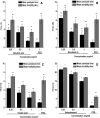In vitro anthelmintic assessment of selected phytochemicals against Hymenolepis diminuta, a zoonotic tapeworm
- PMID: 27605841
- PMCID: PMC4996173
- DOI: 10.1007/s12639-014-0560-1
In vitro anthelmintic assessment of selected phytochemicals against Hymenolepis diminuta, a zoonotic tapeworm
Abstract
A large number of medicinal plants are used as herbal remedy for the treatment of helminthic diseases in the developing countries, however, far too little attention has been paid to assess the anthelmintic potentials of chemical compounds that are present in these plants. This study was carried out to assess the in vitro anthelmintic effects of biochanin A, ursolic acid, betulinic acid and beta-sitosterol which are the major phytochemicals of Trifolium repens, Houttuynia cordata and Lasia spinosa, the traditionally used anthelmintic plants of Northeast India. The in vitro anthelmintic testing of these phytochemicals was undertaken against Hymenolepis diminuta, a zoonotic tapeworm, and their efficacy was compared with a reference drug, praziquantel. The results revealed that except beta-sitosterol, which showed a very weak anthelmintic effect, remaining all other tested compounds possess highly significant (p ≤ 0.001) and dose-dependent anthelmintic effects. Upon exposure to 0.25, 0.50 and 1 mg/ml concentrations of biochanin A, ursolic acid and betulinic acid, the test parasite H. diminuta, at first, showed a paralyzed state which later culminated into their mortality after short time periods. Of all the phytochemicals tested, betulinic acid (1 mg/ml) showed the best anthelmintic effect and caused the mortality of test parasites at 3.4 ± 0.66 h. In conclusion, the results of this study demonstrate for the first time that betulinic acid, biochanin A and ursolic acid possess significant in vitro anthelmintic effects against H. diminuta, a zoonotic tapeworm, and, therefore, these compounds may be exploited further for anthelmintic drug development.
Keywords: Anthelmintics; Beta-sitosterol; Betulinic acid; Biochanin A; Hymenolepis diminuta; Phytochemicals; Ursolic acid.
Figures

Similar articles
-
Gallic acid and Catechin induce morphological alterations on the zoonotic parasite Hymenolepis diminuta.Parasitol Res. 2023 Oct;122(10):2287-2299. doi: 10.1007/s00436-023-07929-w. Epub 2023 Jul 29. Parasitol Res. 2023. PMID: 37507540
-
Anthelmintic effects of Oroxylum indicum stem bark extract on juvenile and adult stages of Hymenolepis diminuta (Cestoda), an in vitro and in vivo study.Parasitol Res. 2016 Mar;115(3):1275-85. doi: 10.1007/s00436-015-4864-6. Epub 2015 Dec 10. Parasitol Res. 2016. PMID: 26660694
-
In vitro and in vivo anthelmintic effects of Caesalpinia bonducella (L.) Roxb. leaf extract on Hymenolepis diminuta (Cestoda) and Syphacia obvelata (Nematoda).J Intercult Ethnopharmacol. 2016 Aug 22;5(4):427-433. doi: 10.5455/jice.20160821024821. eCollection 2016 Sep-Dec. J Intercult Ethnopharmacol. 2016. PMID: 27757275 Free PMC article.
-
The Tapeworm Hymenolepis diminuta as an Important Model Organism in the Experimental Parasitology of the 21st Century.Pathogens. 2022 Nov 29;11(12):1439. doi: 10.3390/pathogens11121439. Pathogens. 2022. PMID: 36558772 Free PMC article. Review.
-
Worldwide overview of human infections with Hymenolepis diminuta.Parasitol Res. 2020 Jul;119(7):1997-2004. doi: 10.1007/s00436-020-06663-x. Epub 2020 Mar 24. Parasitol Res. 2020. PMID: 32211990 Review.
Cited by
-
The therapeutic potential of Houttuynia cordata: A current review.Heliyon. 2022 Aug 24;8(8):e10386. doi: 10.1016/j.heliyon.2022.e10386. eCollection 2022 Aug. Heliyon. 2022. PMID: 36061012 Free PMC article. Review.
-
In vitro anthelmintic efficacy of Ferulic and Sinapic acid against zoonotic cestode Hymenolepis diminuta (Rudolphi, 1819).J Parasit Dis. 2024 Sep;48(3):501-513. doi: 10.1007/s12639-024-01689-9. Epub 2024 May 22. J Parasit Dis. 2024. PMID: 39145371
-
β-sitosterol Mediated Silver Nanoparticles Induce Cytotoxicity in Human Colon Cancer HT-29 Cells.Avicenna J Med Biotechnol. 2021 Jan-Mar;13(1):42-46. doi: 10.18502/ajmb.v13i1.4577. Avicenna J Med Biotechnol. 2021. PMID: 33680372 Free PMC article.
-
Gallic acid and Catechin induce morphological alterations on the zoonotic parasite Hymenolepis diminuta.Parasitol Res. 2023 Oct;122(10):2287-2299. doi: 10.1007/s00436-023-07929-w. Epub 2023 Jul 29. Parasitol Res. 2023. PMID: 37507540
-
Therapeutic efficacy of β-sitosterol treatment on Trypanosoma congolense infection, anemia development, and trans-sialidase (TconTS1) gene expression.Front Microbiol. 2023 Sep 27;14:1282257. doi: 10.3389/fmicb.2023.1282257. eCollection 2023. Front Microbiol. 2023. PMID: 37886075 Free PMC article.
References
LinkOut - more resources
Full Text Sources
Other Literature Sources
